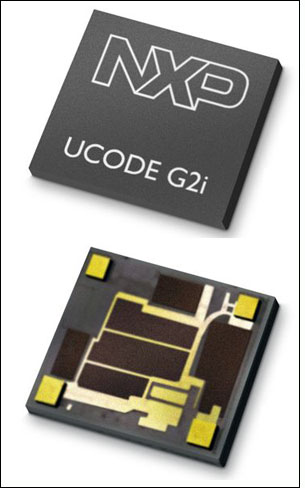Apr 06, 2010NXP Semiconductors has unveiled two new passive ultrahigh-frequency (UHF) RFID chips for use by the fashion and electronics markets that will make EPC Gen 2 item-level tags more sensitive by requiring less power to operate. The chips feature privacy, security and anti-tampering functions, and one model allows users to send commands to their electronics via the RFID connection. The chips, based on the ISO 18000-6C standard, were developed to target high-volume, item-level tagging.
The UCode G2iL and G2iL+ chips, expected to be commercially available in June 2010, come with a variety of functions designed to resolve the shortcomings of typical item-level tags, according to NXP—namely, insufficient read rates and consumers' privacy concerns that tags might be readable outside of a store. In addition, the G2iL+ enables a tag to link firmware upgrades or other information to an electronic device, such as a cell phone or an MP3 player, by receiving data via RFID and forwarding it directly to the device's microcontroller, to which the tag is hardwired. Both chips are specified to operate across the 840 to 960 MHz UHF band, making them useable globally.
The new chips, according to Ralf Kodritsch, NXP Semiconductors' UCode marketing manager, are the company's response to the retail industry's requests to make tags more sensitive (by requiring a less powerful signal from an RFID interrogator in order to operate), more secure from a privacy standpoint (because they can be turned off), able to have their read range shortened, and tamper-proof (since they transmit an alert if someone tears or cuts a tag).
Both versions are more efficient than most other UHF EPC Gen 2 tags currently on the market, Kodritsch says, requiring about half the power to be activated. This, he notes, results in a higher read rate, while enabling the use of smaller tag antennas—and, consequently, the design of smaller tags.
For those in the fashion and electronics sector, improved read rates are critical. If tagged items are placed within boxes that are then stacked on pallets and passed through a reader portal, users need a system able to capture 100 percent of those tags, including those packed in the center of the stack. The new NXP chips, Kodritsch indicates, will help tag manufacturers get closer to achieving this 100 percent goal.
Both chips also come with a tag tamper alarm, made possible by a small wire that connects two metal pins on the chip. If that wire were to break (as would happen if someone attempted to cut or tear the tag, or peel it off an item to which it was attached via adhesive), the chip would send an alert, along with the transmission of its own ID number, when read by an interrogator. With this function, stores could install a reader in changing rooms, for example, and detect, in real time, if a person tried to disable a tag or move it to a different garment.
Like NXP's older UCode G2XL and G2XM RFID chips (see Raflatac Releases RFID Tags With Built-In EAS), the G2iL and G2iL+ also provide an anti-theft function, enabling an RFID deployment to operate as an electronic surveillance alarm (EAS) system. This feature is made possible by an extra bit of memory that can be toggled between 1 and 0, thereby indicating whether or not an item to which it is attached has been purchased. Based on the reading of this bit, the software controlling the interrogators will issue an alarm if unsold merchandise is detected moving through a store's exit (assuming an RFID reader is located at that spot). The interrogator also receives the tag's unique ID number as the alert sounds, thus letting a retailer know which item is being taken from its premises.
The G2iL+ comes with a read-range reduction option enabling users to set the tag to continue transmitting, but at a reduced power level, so that an interrogator would need to be within an inch or two of the tag in order to read it. That reduced read range would allow the tag to pass through an RFID portal as a customer leaves the store, and would also prevent anyone from reading the tag surreptitiously, since the interrogator would need to be very close to the tag to accomplish a read. This function, NXP Semiconductors reports, makes it easier for retailers to receive returned items, with the tag still attached and still emitting an ID number.
In addition, the G2iL+ chip has a digital-switch function allowing users to communicate directly with an electronic product in which such a chip is installed. Manufacturers could install the chip during the assembly of an electronic device or appliance, with the chip hardwired to a microcontroller.
The digital switch can be employed to activate and deactivate that electronic product at the required time, such as at the point of sale. Therefore, the device simply would not operate until that product's microcontroller received instructions from the G2iL+ chip to do so. This function, Kodritsch says—which could be utilized by manufacturers and retailers to thwart gray markets in which products are sold outside of an authorized supply chain—works not only with cellular phones and other electronics, but also with white goods (heavy consumer durables, such as air conditioners, refrigerators and stoves), as well as televisions and industrial electronics.
The G2iL+ chip also has a battery-assist mode for applications such as tagging containers. If a battery is added to a tag with a G2iL+ chip (thereby making it a semi-active tag) the tag's read range could double, Kodritsch says—up to 20 meters (66 feet); without battery assistance, the read range is 10 meters (33 feet). The battery boosts the read range by powering the "signal-receiving" part of a tag's operation, and also powers the digital switch and data-transfer function for loading firmware into an electronic product's microcontroller.
With the release of the new chips, Kodritsch says, "Our hope is two-fold." The greater sensitivity, he notes, will help the retail market ensure up to 100 percent read rates of item-level tags, while the anti-tampering feature "raises the bar for theft prevention in the retail area."
According to Kodritsch, NXP Semiconductors developed these chips based on discussions it held with companies in the retail industry. "Customers are very keen on using this," he says.
Both the G2iL and G2iL+ chips come with 128 bits of EPC memory and 64-bit TID, including a 32-bit serial number. They will be sold either in the form of a wafer, as a small package (individual chips measuring 485 µm by 435 µm) or as a flip-chip strap onto which an IC is mounted. The G2iL will be priced similarly to the firm's other EPC Gen 2 UHF chips, Kodritsch says, while the G2iL+ will be somewhat more expensive, though that cost would depend on the volume purchased. By June, he notes, RFID inlay manufacturers such as Avery Dennison, UPM Raflatac and Confidex will incorporate the chips into their products. In addition, NXP will continue to make and sell its UCode G2XM and G2XL chips.



